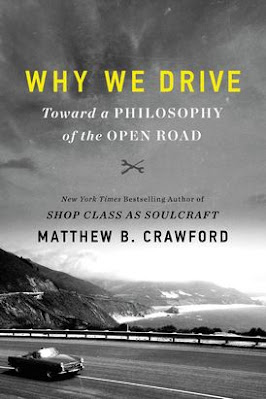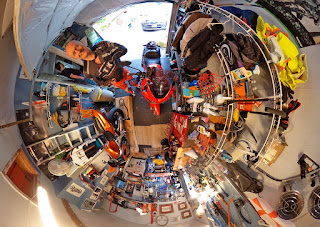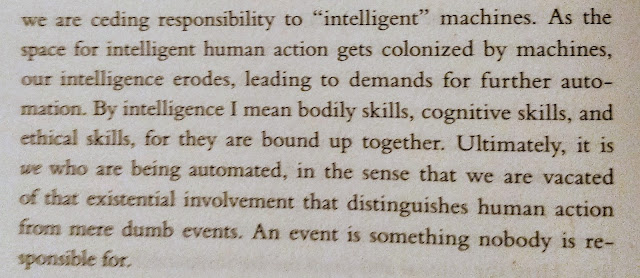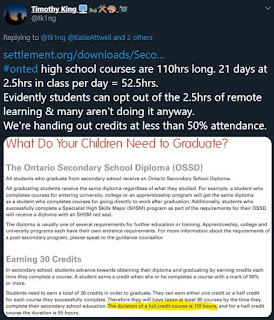We recently spent a day in Stratford and one of the more surprising and engaging events was a Q&A talk with two of the Festival’s experienced actors. Maev Beatty and Ben Carlson are both starring in The Front Page. We hadn’t seen the play and I was a bit worried that it’d be all about that, but it wasn’t at all. When you get two smart, capable professionals showing you inside their process, whatever their profession, it’s an enlightening experience. Here are some of the highlights that I’m still mulling over:
Adrenaline
Early on someone intimated that it must be nice only having to work 2-3 times a week for a couple of hours and I think both actors bristled at that suggestion. One of the stresses on acting that most people wouldn’t think about is the physiology of putting yourself out there in an absolute physical sense. On an evening you’re going on stage you typically start to feel that intensity in the early afternoon. By the time you’re on stage your adrenaline is peaking and, though they didn’t mention it, I doubt many actors can go right to bed after performing. Ben noted a study that showed a working actor experiences as much adrenaline as you’d feel in a car accident, times two! He noted that if a normal person were to receive that much adrenaline at once they’d have a heart attack and die; it’s a high intensity high.
There’s something to be said for putting yourself out there. It’s one of the reasons I encourage my students into competition. The heightened sense of purpose that burst of adrenaline gives you allows you to do things you might not otherwise be able to do. Experiencing that intensity also teaches you to manage it. This is one of the reasons why I think things like school plays, competitions and sports are so important, yet they tend to be the first thing we throw under the bus when we start to look for ‘extracurriculars’ to cut. The fact that the school system calls them extracurriculars is telling in and of itself.
Teaching students to take risks and manage the adrenaline that comes from it should be a vital part of any school experience, but the vast majority of students running through schools don’t and the few that do tend to be the most economically advantaged ones; that’s a real system failure.
Watching these two professionals, who do a job that most people would find too terrifying to imagine (me being one of them), and listening to how they deal with that terror, was fascinating. Many people say they wish they had a job like that, an extreme job that demands all of you, but even taking the exceptional skill-sets required out of the equation, the vast majority of people couldn’t take the heat of working in a kitchen like that. For all the jealousy people feel for successful actors, musicians or athletes, most couldn’t handle the intensity of a life like that. The amount of work involved puts it beyond the reach of most, but it’s the performance aspect that people don’t think about. The wear and tear on their minds and bodies is astonishing.
Failure
There were a lot of questions around how you deal with failure in theatre production, including a number of questions about how you deal with poor performers or productions, but the most telling moment, again, I suspect in response to that initial intimation that acting was an easy gig, was how they both described auditioning.
These are two of Canada’s more well known actors and both are making a good living at it. When asked if they still had to audition, they both said they did. Ben suggested you could find the odd moment when you’d just give a hard no, but that isn’t generally the place of an actor. Actors act and to do that you audition.
Once again referring back to how a Stratford actor fills their idle days, both said it isn’t uncommon for people in the troop to be on stage in up to half a dozen different plays, all of which required thousands of hours of preparation and rehearsal. Since all actors are inherently self-employed, they also have to keep their ears to the ground in terms of possible TV and film opportunities and prepare auditions for them, which also take time and commitment. The agonizing thing about this is that the vast majority, even if you’re a well known name, end up giving you back nothing. To the I-do-work-and-get-paid-for-it crowd, this is yet another example of why one of those dream jobs like acting isn’t what you think it is.
 Both Maev and Ben described weeks where they would audition almost daily and walk away empty handed. Their experience has taught them to not take this personally (casting is alchemical and complicated and not about who is most well known).
Both Maev and Ben described weeks where they would audition almost daily and walk away empty handed. Their experience has taught them to not take this personally (casting is alchemical and complicated and not about who is most well known).
At another point someone asked if they could create productions that suited them, but they said an obvious truth: “that’s not the job of an actor.” They also mentioned that that’s a good thing. Twenty-something Ben would have told you he could do anything, but the wiser, older Ben knows now that he couldn’t. Letting directors direct and actors act is yet another of those intensity based requirements that we should consider in a classroom, but don’t because we shy away from genuine experiences in favour of artificially successful ones.
I’ve long talked about risk aversion and modern education’s almost psychotic insistence on success for everyone all the time. Building resilience in an environment like that is nearly impossible. Failure and our response to it is vital in everything from daily life to the grand trajectory of our lives. Our education system is still built on the idea of passing and failing, but failing is where we learn the most and gain the least in our system.
Watching two toughened veterans of a brutal industry might make you think that they have become hardened themselves, but another repeating theme of their talk was in surviving the onslaught of theatre by working with the right people…
Working from a place of love and support
In the fiery crucible of the stage you really don’t want to be doubting where the people you’re in there with are coming from. Any ideas of office politics or drama (the pedantic kind) make working in such an intense situation untenable. Maev talked about a few productions where the people on stage were very difficult to work with due to their nastiness, but as a general rule this isn’t how actors relate.
When you’re displaying that kind of vulnerability on the stage you don’t want to be wondering if your partner is going to throw you under the bus. She said, and it has stuck with me, that ” you want to be working with people who are coming from a place of love and support”. Even under the crushing pressure of a live stage performance with everyone OD’ed on adrenaline, knowing that your colleagues have your back is vital.
I’ve been in situations where the pressure has created friendships that have lasted the rest of my life. I can only imagine the personal connection actors feel with each other after going through that glorious hell together. Staring into the abyss but knowing the person next to you isn’t going to let you down allows you to do incredible things, like create live art on stage.
That kind of empathic bonding is something else that too few students get to enjoy in school. Once again this is a division of the haves and havenots. The kids who have to go to work right after school never get to develop that sense of belonging whether it’s on a sports team or a stage production or a technical competition, and that’s a tragedy. From that angle there is nothing extra about those extracurriculars. There is a reason why you can’t remember a single lesson from high school but those experiences are pivotal to who you are today. We’d be insane to dismantle them and should instead be incorporating them into learning expectations for all students. Who doesn’t deserve to learn what that kind of love, belonging and support feels like?
Loving a bad character
The idea of having to act a character you hate came up along with the how do you work in a bad production or with bad people questions – there was a lot of curiosity from the audience about how things might go wrong. The positivity and boundless optimism of the responses points to yet another difference between most people and the few who are willing to throw themselves at seemingly impossible jobs.
Ben’s answer to this once again pointed to that idea of positivity overcoming seemingly insurmountable odds. He and Maev gave several examples of characters they found so difficult that it seemed impossible to express them well. In looking at the character, Ben said he always looks for something he can love about them and works from that. Unlike the unwashed masses, actors can’t work from a binary place of I like ’em or I don’t like ’em. This must seep out into their dealings with other people, though they didn’t mention that.
This was yet another theme that paralleled my own professional experience. I’ve had students who I couldn’t stand, but I’ve always tried to operate from a place of positivity. In getting to know them, I’ve always found some aspect of them that is worthy of appreciation. It’s that approach that keeps me away from the staff room where well meaning binary colleagues want to tell you what a worthless piece of shit a child is when you mention that you’re teaching them for the first time. I’ve never met a person so unworthy of any consideration.
Simple Magic
My glorious wife, Alanna, asked a question that had been tugging on her since our last trip to Stratford. I commented, in my usual way, about how we are quite venerable ourselves and yet we were the youngest people in the audience by a decade or more. In twenty years that theatre would be mostly empty. My conclusion was that theatre is dying with this demographic. The audience at the Q&A were of a similar demographic.
Alanna asked if theatre was evaporating before our eyes and Ben picked this up with glee. He noted that theatre has been dying for centuries, but what always saves it is its simplicity. If you have an actor and an audience, you have theatre. In talking it through, and this happened on many questions, both actors would think through the implications of a question out loud, he unpacked the history of theatre and came to a conclusion about how it always seems to survive its imminent demise; at its root, theatre is about people getting together.
That simple magic is what keeps theatre alive; it feeds a human need to gather together. No number of screens, wifi or virtual presences have satisfied that need, and he noted there is some push back against the direction this has taken. Making anonymous or even just remote comments online is nothing like the same as having a face to face encounter. My role as a computer teacher and technician has no issue with this observation. There is a quality in face to face human interaction that not only satisfies a deep human need, but also never be achieved through digitization, something will always be lost in translation whether through a lack of fidelity or a genuine presence and responsibility.
Theatre, like schools, libraries, concerts or sporting events, offer people something that digital experiences don’t. That complexity of presence (call in bandwidth if you want) and sense of belonging call powerfully to the human psyche. The sense of being there is important, though our digital adolescence crops up there too with idiots on lousy cell phone cameras making terrible media instead of enjoying the moment they went to so much trouble to experience first hand.
The current drive to elearning as a cost effective way to deliver learning is yet another example of failing forward into the idea that digital experiences can replace the real world. It’s cheaper because it isn’t as good. If you consider it from a bandwidth perspective, the sheer amount of data passing between a teacher and student in even a simple face to face encounter is something digital simply can’t touch. Augment? Assist? Absolutely, but we replace basic human needs with poor digital equivalents at our own peril (and a multi-national’s profit). We’re all poorer as a few get rich in this scenario.
 That response got me thinking about how we prioritize our lives. I’m an avid photographer, always have been, which is one of the reasons I don’t have a lousy cell phone camera in my hand all the time, especially when I’m at an event. If I take a photo, it’s gonna be a good one.
That response got me thinking about how we prioritize our lives. I’m an avid photographer, always have been, which is one of the reasons I don’t have a lousy cell phone camera in my hand all the time, especially when I’m at an event. If I take a photo, it’s gonna be a good one.
Sean Penn has a great line in The Secret Life of Walter Mitty when he’s talking about being in the moment instead of trying to record it, and he’s speaking about it from the perspective of a photographic artist, not some idiot with a cell phone in their hands. These digital invasions, ironically driven by our need for digitally impoverished social contact, are eating away at our lived experience.
Simple magic is a good way to look at many aspects of modern life. What core needs do human beings have and how have we always met them socially? Are we meeting them as well in digital media? Theatre is going to survive because it has more in common with genuine human need than social media ever will, and it’s able to do it in a simple and direct way. The response to Alanna’s question gives me hope that one day we’ll wake up from this attention economy nightmare we’ve immersed ourselves in.
***
I went to this initially thinking that it would be a bunch of theatre shop talk, but there was barely any (and what there was came mostly from the audience). Instead it was an introspective and insightful talk by two talented people at the height of their powers. Their understanding of themselves, their art and the insight it gives them into the human condition makes it a must-do for anyone who can get out to Stratford… and it’s free! It runs into October – a field trip including a talk like this (though each is, of course, different) could change lives.
from Blogger https://ift.tt/2P5UrTl
via IFTTT































